Input interpretation

cyclopropanemethanol
Chemical names and formulas
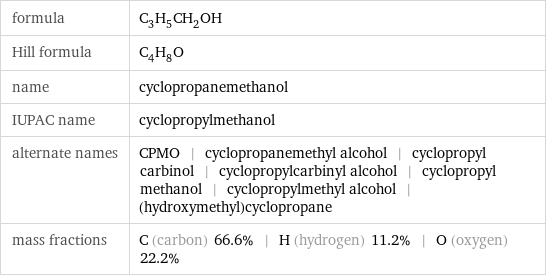
formula | C_3H_5CH_2OH Hill formula | C_4H_8O name | cyclopropanemethanol IUPAC name | cyclopropylmethanol alternate names | CPMO | cyclopropanemethyl alcohol | cyclopropyl carbinol | cyclopropylcarbinyl alcohol | cyclopropyl methanol | cyclopropylmethyl alcohol | (hydroxymethyl)cyclopropane mass fractions | C (carbon) 66.6% | H (hydrogen) 11.2% | O (oxygen) 22.2%
Lewis structure
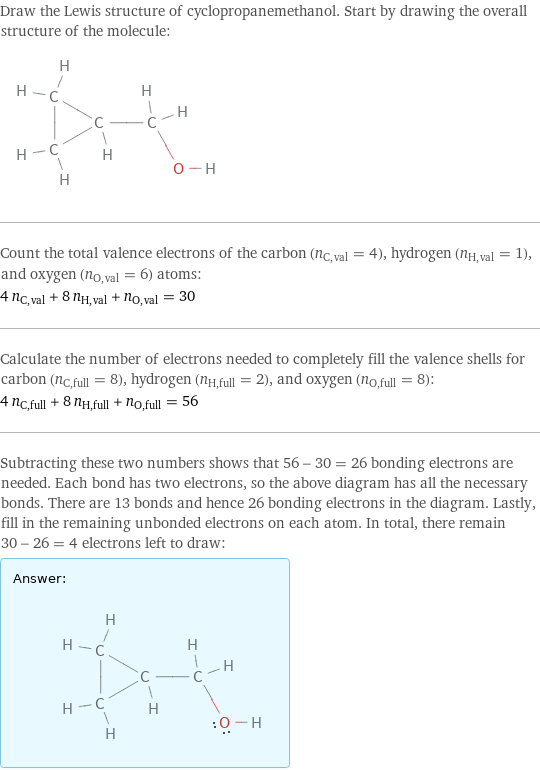
Draw the Lewis structure of cyclopropanemethanol. Start by drawing the overall structure of the molecule: Count the total valence electrons of the carbon (n_C, val = 4), hydrogen (n_H, val = 1), and oxygen (n_O, val = 6) atoms: 4 n_C, val + 8 n_H, val + n_O, val = 30 Calculate the number of electrons needed to completely fill the valence shells for carbon (n_C, full = 8), hydrogen (n_H, full = 2), and oxygen (n_O, full = 8): 4 n_C, full + 8 n_H, full + n_O, full = 56 Subtracting these two numbers shows that 56 - 30 = 26 bonding electrons are needed. Each bond has two electrons, so the above diagram has all the necessary bonds. There are 13 bonds and hence 26 bonding electrons in the diagram. Lastly, fill in the remaining unbonded electrons on each atom. In total, there remain 30 - 26 = 4 electrons left to draw: Answer: | |
3D structure

3D structure
Basic properties
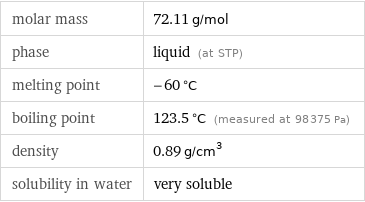
molar mass | 72.11 g/mol phase | liquid (at STP) melting point | -60 °C boiling point | 123.5 °C (measured at 98375 Pa) density | 0.89 g/cm^3 solubility in water | very soluble
Units

Liquid properties (at STP)
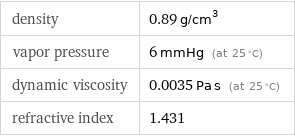
density | 0.89 g/cm^3 vapor pressure | 6 mmHg (at 25 °C) dynamic viscosity | 0.0035 Pa s (at 25 °C) refractive index | 1.431
Units

Thermodynamic properties

molar heat of vaporization | 42.2 kJ/mol specific heat of vaporization | 0.585 kJ/g (at STP)
Chemical identifiers

CAS number | 2516-33-8 Beilstein number | 1846846 PubChem CID number | 75644 PubChem SID number | 24871809 SMILES identifier | C1CC1CO InChI identifier | InChI=1/C4H8O/c5-3-4-1-2-4/h4-5H, 1-3H2 RTECS number | GZ2212250 MDL number | MFCD00001309
NFPA label

NFPA label
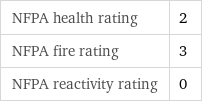
NFPA health rating | 2 NFPA fire rating | 3 NFPA reactivity rating | 0
Safety properties

flash point | 35 °C autoignition point | 310 °C

DOT hazard class | 3 DOT numbers | 1987
Toxicity properties

RTECS classes | other